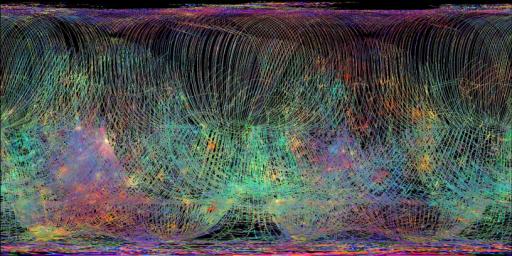The Mercury Atmospheric and Surface Composition Spectrometer (MASCS) collects hundreds of different wavelengths of light, ranging from the ultraviolet through the near-infrared, to probe the mineralogy of the surface of Mercury. These spectra are visualized by mapping different wavelengths or combinations of wavelengths into red, green, and blue, so the human eye can distinguish them. The multicolored 'fireworks' result from a combination of physical and chemical differences on the surface, including mineralogical diversity and the exposure age of the craters.
The VIRS composite shows over 1.5 million individual footprints compiled since MESSENGER entered orbit, with MESSENGER viewing the surface from different directions and at different altitudes. In locations where multiple footprints cover the same area, the footprint with the best illumination for mineralogical interpretation (usually the lowest incidence angle where shadows are minimized) is used for making the map.
Date Created: December 21, 2012
Instrument: Visible and Infrared Spectrograph (VIRS) of the Mercury Atmosphere and Surface Composition Spectrometer (MASCS)
Center Latitude: 0°
Center Longitude: 0° E
VIRS Color Composite Wavelengths: 575 nm as red, 415 nm/750 nm as green, 310 nm/390 nm as blue
The MESSENGER spacecraft is the first ever to orbit the planet Mercury, and the spacecraft's seven scientific instruments and radio science investigation are unraveling the history and evolution of the Solar System's innermost planet. Visit the Why Mercury? section of this website to learn more about the key science questions that the MESSENGER mission is addressing. During the one-year primary mission, MDIS acquired 88,746 images and extensive other data sets. MESSENGER is now in a year-long extended mission, during which plans call for the acquisition of more than 80,000 additional images to support MESSENGER's science goals.
For information regarding the use of images, see the MESSENGER image use policy.

 Planetary Data System
Planetary Data System












